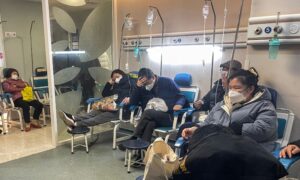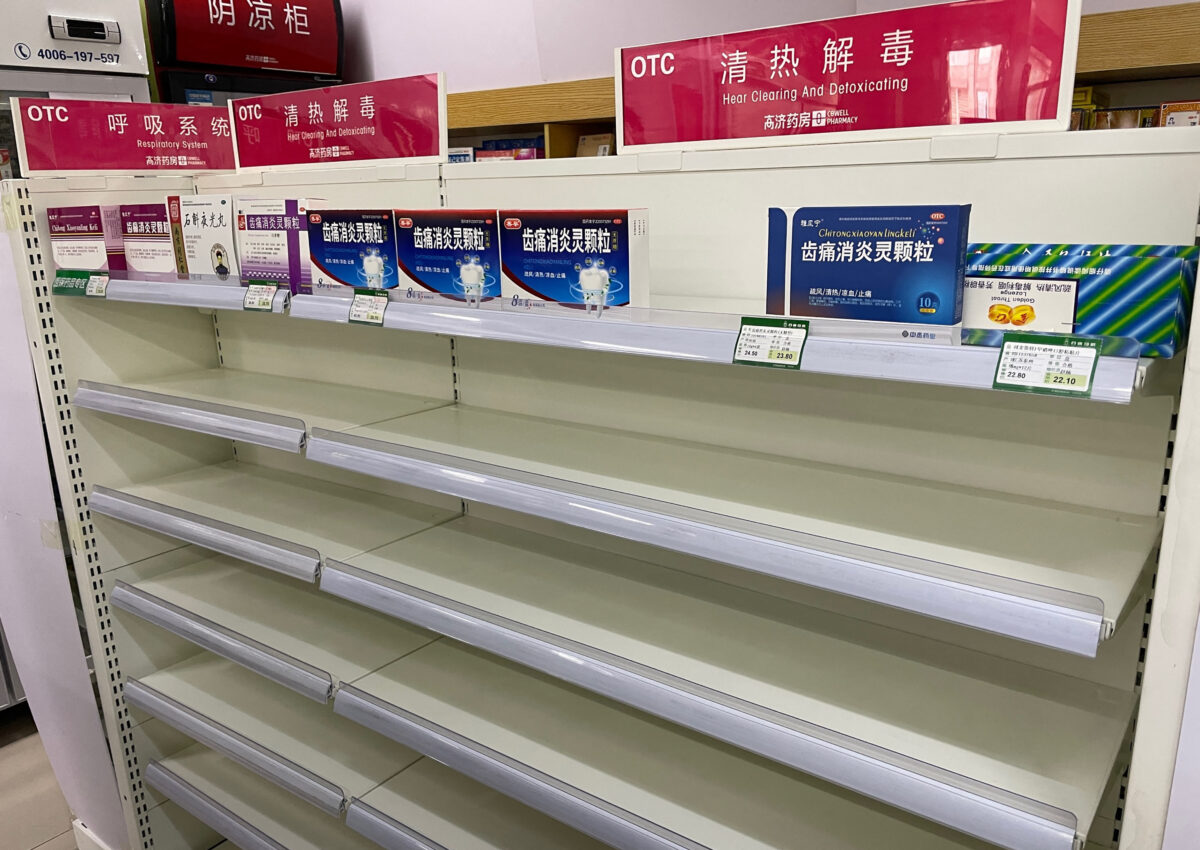1-2 Million COVID Deaths Likely in China
CommentaryChina’s dam against COVID-19 has broken. Beijing canceled lockdowns precipitously, and the resulting tidal wave of infections is inundating the country. Hundreds of millions of Chinese are now estimated to have COVID. China’s biggest cities, including Beijing, are the hardest hit. Half of Shanghai could already be infected. Modeling predicts as many as 1 to 2 million deaths in China will result from the current wave. Omicron has been less deadly elsewhere due to mature vaccination campaigns, exposure to prior variants, better medical technologies, and developed hospital infrastructure, including the multiplication of fully-equipped intensive care units. The regime in Beijing, however, prioritized lockdowns and neglected the rest. The Chinese Communist Party (CCP) rejected the best medicines from the West, including mRNA vaccines produced by Pfizer, Moderna, and BioNTech. The CCP also neglected monoclonal antibody medicines, such as Paxlovid and Evusheld, to prevent COVID and treat mild and moderate cases. Only in February did Beijing approve Paxlovid for emergency use. But except for Party elites and their friends, supply lags demand. Local companies that produce competing products are the intended beneficiaries. The CCP is so unprepared for the current wave of infections in China that many of the country’s elderly, who are most at risk from COVID, are unvaccinated or unboosted using even locally-developed and relatively ineffective Sinovac and Sinopharm vaccines. Rather than prioritize the most elderly populations for vaccination, as in the West, the regime focused on working-age populations, apparently as a triage measure. Until March 2021, those aged over 60 in China were banned from receiving vaccines. That ban should be considered criminal. Pharmacies in cities across the mainland report shortages of antigen tests, off-the-shelf fever medicines, and ibuprofen, leading concerned family members in Singapore and Hong Kong to send basic cold medicines by post. They can take a week to arrive. Cold medicine is in short supply in pharmacies amid the COVID-19 pandemic in Beijing on Dec. 15, 2022. (Yuxuan Zhang/AFP via Getty Images) Emergency rooms in China are low on oxygen and staff. Retired medical personnel are recalled and required to work even if sick from COVID. The CCP has refused offers by the United States to supply medication on an emergency basis. The regime’s hyper-nationalism likewise led to the refusal of the West’s mRNA vaccines. Beijing is apparently too proud to accept any assistance from the West, even in life-or-death situations, to avoid demonstrating to regular Chinese citizens that the CCP is not, in fact, at the cutting edge of biotechnology. The cover-up of overflowing hospitals and morgues is a stunning failure by the CCP, whose cover-ups caused the global pandemic in the first place. Had the regime followed protocols developed after the SARS epidemic in the early 2000s, COVID might have been nipped in the bud, and almost 7 million global deaths, so far, avoided. Now the world, including Chinese citizens, trusts the regime less than ever. Due to the current wave of infections, and the CCP’s upcoming opening of the country’s borders for mainland travelers after Jan. 8, the world is increasing protective measures while Beijing downgrades its own. The result is convergence. After Jan. 8, China will shift from eight days of quarantine for incoming travelers to just a negative test within 48 hours of travel. Several countries are doing the same to China. The United States, Japan, Taiwan, Malaysia, Italy, and India have all increased rules for travelers from the country. The strategy seeks to stop new post-Omicron variants from spreading beyond China. But the measures will have little effect as such variants can develop anywhere, and travelers from China are, in any case, fanning out to third countries that have no such restrictions. The new measures against Chinese travelers, including by the Biden administration, are better understood as “political inoculation,” according to The Wall Street Journal. They allow politicians to claim they did something about China’s current COVID wave and avoid obvious cases on planes. But they do little else. The CCP is desperately trying to hide its latest COVID wave while simultaneously directing blame to November’s anti-lockdown protesters. But the fault is with the CCP alone. Its lack of transparency and planning failures directly result from its authoritarian medical and economic policies. It trumpeted its authoritarianism over the past three years, but in the final analysis, CCP leader Xi Jinping is again demonstrating that communism fails disastrously. The 1.4 billion Chinese people are the victims. Transparency, democracy, and the market economy, including in pharmaceutical development, again prove its life-saving superiority. Views expressed in this article are the opinions of the author and do not necessarily reflect th

Commentary
China’s dam against COVID-19 has broken. Beijing canceled lockdowns precipitously, and the resulting tidal wave of infections is inundating the country.
Hundreds of millions of Chinese are now estimated to have COVID. China’s biggest cities, including Beijing, are the hardest hit. Half of Shanghai could already be infected. Modeling predicts as many as 1 to 2 million deaths in China will result from the current wave.
Omicron has been less deadly elsewhere due to mature vaccination campaigns, exposure to prior variants, better medical technologies, and developed hospital infrastructure, including the multiplication of fully-equipped intensive care units.
The regime in Beijing, however, prioritized lockdowns and neglected the rest. The Chinese Communist Party (CCP) rejected the best medicines from the West, including mRNA vaccines produced by Pfizer, Moderna, and BioNTech. The CCP also neglected monoclonal antibody medicines, such as Paxlovid and Evusheld, to prevent COVID and treat mild and moderate cases.
Only in February did Beijing approve Paxlovid for emergency use. But except for Party elites and their friends, supply lags demand. Local companies that produce competing products are the intended beneficiaries.
The CCP is so unprepared for the current wave of infections in China that many of the country’s elderly, who are most at risk from COVID, are unvaccinated or unboosted using even locally-developed and relatively ineffective Sinovac and Sinopharm vaccines.
Rather than prioritize the most elderly populations for vaccination, as in the West, the regime focused on working-age populations, apparently as a triage measure. Until March 2021, those aged over 60 in China were banned from receiving vaccines. That ban should be considered criminal.
Pharmacies in cities across the mainland report shortages of antigen tests, off-the-shelf fever medicines, and ibuprofen, leading concerned family members in Singapore and Hong Kong to send basic cold medicines by post. They can take a week to arrive.

Emergency rooms in China are low on oxygen and staff. Retired medical personnel are recalled and required to work even if sick from COVID.
The CCP has refused offers by the United States to supply medication on an emergency basis. The regime’s hyper-nationalism likewise led to the refusal of the West’s mRNA vaccines. Beijing is apparently too proud to accept any assistance from the West, even in life-or-death situations, to avoid demonstrating to regular Chinese citizens that the CCP is not, in fact, at the cutting edge of biotechnology.
The cover-up of overflowing hospitals and morgues is a stunning failure by the CCP, whose cover-ups caused the global pandemic in the first place. Had the regime followed protocols developed after the SARS epidemic in the early 2000s, COVID might have been nipped in the bud, and almost 7 million global deaths, so far, avoided.
Now the world, including Chinese citizens, trusts the regime less than ever. Due to the current wave of infections, and the CCP’s upcoming opening of the country’s borders for mainland travelers after Jan. 8, the world is increasing protective measures while Beijing downgrades its own. The result is convergence.
After Jan. 8, China will shift from eight days of quarantine for incoming travelers to just a negative test within 48 hours of travel. Several countries are doing the same to China. The United States, Japan, Taiwan, Malaysia, Italy, and India have all increased rules for travelers from the country.
The strategy seeks to stop new post-Omicron variants from spreading beyond China. But the measures will have little effect as such variants can develop anywhere, and travelers from China are, in any case, fanning out to third countries that have no such restrictions.
The new measures against Chinese travelers, including by the Biden administration, are better understood as “political inoculation,” according to The Wall Street Journal. They allow politicians to claim they did something about China’s current COVID wave and avoid obvious cases on planes. But they do little else.
The CCP is desperately trying to hide its latest COVID wave while simultaneously directing blame to November’s anti-lockdown protesters. But the fault is with the CCP alone. Its lack of transparency and planning failures directly result from its authoritarian medical and economic policies. It trumpeted its authoritarianism over the past three years, but in the final analysis, CCP leader Xi Jinping is again demonstrating that communism fails disastrously.
The 1.4 billion Chinese people are the victims. Transparency, democracy, and the market economy, including in pharmaceutical development, again prove its life-saving superiority.
Views expressed in this article are the opinions of the author and do not necessarily reflect the views of The Epoch Times.












